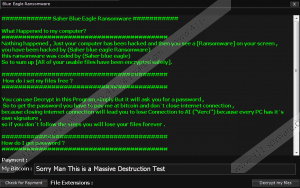BlueEagle Ransomware Removal Guide
A new ransomware infection BlueEagle Ransomware has been detected by our researchers. It still seems to be in development, but, according to specialists, it might one day become a prevalent infection. If this happens and it somehow slithers onto your computer, you will find your files, including pictures, music, and documents, encrypted because it is one of those ransomware infections that lock the personal data to make it easier for cyber criminals to get what they want, i.e., users’ money. You should not make a payment to cyber criminals behind this ransomware infection even if you need some of these encrypted files back badly because the chances are high that you will just encourage cyber criminals to continue developing all kinds of malicious applications. To put it differently, you might not get the key to unlock those encrypted files even if you pay the ransom. Because of this, you should go to remove BlueEagle Ransomware from your system first things first. Once it is gone, you could think about the decryption of files. It will definitely not be easy to get them back because this infection also deletes the so-called Shadow Copies of files. To be honest, we cannot even promise that you could restore those corrupted files. In any event, it is necessary to remove the ransomware infection from the system so that it could not cause more problems.
As you already know, BlueEagle Ransomware is a malicious application developed by cyber criminals for money extortion. As a consequence, it performs all activities to obtain easy money. It starts from encrypting users’ personal files. They all get a new extension .SaherBlueEagleRansomware appended to them, and it is no longer possible to open any of them. It is not the only symptom showing that this ransomware infection has slithered onto your computer successfully. Following the successful infiltration, it also kills explorer.exe thus closing Windows Explorer and then places its own window on Desktop. This window contains a ransom note. You can read it if you want to, but you will not find anything new there – like other ransomware-type infections, BlueEagle Ransomware demands a ransom in exchange for the password that can unlock the screen and decrypt files. At the time of writing, the size of the ransom was 1.25 Bitcoin. It is a huge amount of money, so you should not send a cent to cyber criminals. If you do, you might be left both without your files and money because you might still not be able to unlock your encrypted data after making a payment. Needless to say, you will not be given your money back. Therefore, specialists at 411-spyware.com suggest focusing on the removal of BlueEagle Ransomware. Most likely, you will not find a third-party tool that could unlock files locked by this infection because it deletes Shadow Copies of files as well, but you could restore your files from a backup you have after you erase this threat.
It is not easy to talk about the distribution of BlueEagle Ransomware because it is not one of those actively distributed threats. To be frank, it might still be in the development phase. Of course, we cannot promise that cyber criminals will not start spreading it actively. If they ever start distributing it, it is very likely that it will be spread via spam emails mainly, specialists say. Most likely, it will travel as an attachment in them. It has also been observed that many users encounter malicious software if they download applications from third-party pages, e.g. P2P websites. If you are one of them, you should be more careful. We cannot promise that other tactics will not be used to spread BlueEagle Ransomware. Because of this, we highly recommend that you install a security application on your PC as well.
You will not unlock those files BlueEagle Ransomware has locked by erasing this infection from your system, but you still need to remove it from your computer as soon as possible. You will need to remove two .exe files representing this infection, erase all suspicious recently downloaded files in order to remove the malicious file launched, and bring Windows Explorer to life. Before you take action, remove the window placed on your Desktop by killing the malicious process in Task Manager. Use our manual removal guide if you have never deleted such a serious infection yourself before.
How to delete BlueEagle Ransomware
- Press Ctrl+Shift+Esc and open Processes.
- Kill the malicious process representing BlueEagle Ransomware.
- Click File at the top of Task Manager.
- Click New Task (Run...) OR Run new task.
- Type explorer in the box and click OK.
- Open Explorer by tapping Win+E simultaneously.
- Open %TEMP% and delete SaherBlueEagleVirus.exe.
- Remove shadowdeleter.exe from %APPDATA%\Microsoft\Windows\Templates.
- Delete all suspicious files from %USERPROFILE%\Downloads and %USERPROFILE%\Desktop.
- Empty Recycle bin.
BlueEagle Ransomware Screenshots:


